
[To view the full collection of photographs taken by the author, click here.]
Rumour has it there is a sign on the wall inside the Portland Bureau of Planning that declares: “We planned… And it worked!” They’re not wrong. Portland is the poster child for post-war smart growth, the result of meticulous planning and vision, which began in earnest with several key regulatory decisions made in the late 1960s. The first, initiated by a series of freeway revolts, allowed local government to reject the highway building for which federal funds had been earmarked, and redirect them into public transit, including the first section of their vaunted MAX Light Rail system.
America’s only elected regional government – Metro – followed in 1966, which quickly instituted one of the first urban growth boundaries in the United States, simultaneously limiting horizontal sprawl and protecting valuable farmland, by requiring that all subsequent development take place within a well-defined, 400 square mile area. Land-use advocates later formed the ancillary 1000 Friends of Oregon, a nonprofit organization stocked with lawyers to ensure Portland’s prudent planning laws were enforced in expanding suburban jurisdictions.
The Oregon State government meanwhile passed its own visionary legislation in 1971. The Bicycle Bill, as it is affectionately known, still requires a minimum of 1% of all transportation spending to be allocated towards walking and cycling projects. It also necessitates the inclusion of walking and cycling facilities within the right-of-way of every single newly constructed or reconstructed road, street, or highway.
The results of these far-sighted decisions speak for themselves. While the population of the Metro region has doubled since 1966, its footprint has increased just 3%. Portlanders drive 20% fewer miles each day than their U.S. compatriots; this translates to a savings of $1.1 billion each year, of which an estimated $800 million remains in the local economy. Portland is rightly held in high regard in planning, cultural, and bicycle advocacy circles around the world. Observers’ expectations run incredibly high: can the poster-child city continue to meet them?
“America’s Bicycle Capital”
It’s small wonder utility cycling has thrived under such conditions. A temperate climate, combined with this prescient decision-making and compact size mean the City of Roses enjoys the highest bicycle mode share (about 6%) of any large American city (with a population over 300,000). It boasts a vast, 300-mile network of lanes, boulevards, and off-street paths, putting nearly every citizen within 3-6 blocks of a bikeway.
Perhaps the most amazing thing to consider is how so much has been accomplished for so little, other than a significant amount of political will. Officials estimate they have spent $60 million on bike infrastructure over the years: a price tag comparable to a single mile of urban freeway. Much of this has been used to retrofit the many historic bridges that cross the Willamette River, a venture that has paid rich dividends with over 18,000 daily crossings by bike – a staggering 16% of all traffic entering the city centre. And despite nearly 10 million bike trips in 2013, Portland didn’t experience a single fatality; an achievement repeated six out of the last 14 years and one unparalleled in North America.
The Importance of Quality Bike Parking
The planners at Portland’s Bureau of Transportation deserve tremendous credit for recognizing and addressing the importance of providing quality bike parking to encourage transportation cycling. All the bike lanes in the world aren’t worth a dime unless you give your residents a convenient and secure place to lock their bike when they arrive. To that end, city officials have carefully developed a two-pronged attack.
The first is an education program for developers, planners, and advocates. City hall runs a complimentary, A.I.A.-approved class every month to teach the intricacies of designing end-of-trip facilities for office towers and condominiums, which have proved incredibly popular over the years. Meanwhile, Portland State University’s Initiative for Bicycle and Pedestrian Innovation – a national leader in these modes of travel – also offers free classes to local advocates, as a way to give back to their community.
Secondly, and most prominently, planners have designed and executed a bicycle corral program that has been heralded as the best on the continent. The concept is simple: two adjacent, on-street parallel parking spots are reclaimed for bike parking, while simultaneously freeing up valuable sidewalk space. The area required for two motor vehicles is then multiplied with enough room for 20 bikes, swiftly followed by a predictable increase in visitors and economic activity. Since 2004, Portland has installed over 100 such corrals across the city, with merchants now on a two-year waitlist in order to get one installed outside of their business.
Selling Portlandia To The World
There’s no doubt these myriad successes – combined with a shrewd sense of marketing – have helped sell the Portland story to the world. Droves of tourists now flock to the experience the Portlandia they see on television: to ride its plentiful bikeways, drink its craft beer and coffee, and pillage its famous book and record shops. It is precisely those things that keep my family coming back on a yearly basis, often opting to travel car-free, and load our bicycles onto the Amtrak Cascades.
Additionally, numerous figures have emerged from this brand of Portlandian urbanism to take the triumphs and lessons of building its bicycle culture, and help export them to the rest of the world.
Mia Birk – the city’s Bicycle Program Coordinator from 1993 until 1999 – went on to found Alta Planning + Design and Alta Bicycle Share, two separate companies that design, implement, and manage bicycle infrastructure, education, and sharing projects around the world. They have grown from a staff of just three to over 100 transportation specialists, with more than two dozen offices across North America.
Elly Blue – a former managing editor for BikePortland.org – wrote an incredibly popular series of articles for Grist called Bikenomics, which she eventually expanded into a full-length book. Elly is prolific, tirelessly writing for Bicycling, Momentum, The Guardian, and her own blog, Taking The Lane. She has successfully crowd-funded 18 different (fiction and non-fiction) projects via Kickstarter, which are independently published and distributed from her home in southeast Portland.
Resting On Their Laurels
In the summer of 2012, Portland was so confident of its place in the world, that it declared itself America’s Bicycle Capital, boldly painting the phrase in 10-foot high letters on the side of a building downtown.
However, on my most recent trip to this cycling Mecca, I was told this bravado has had two adverse side affects. Firstly, it put a target on the city’s back, motivating more ambitious cities to work even harder. Secondly, it brought with it a sense of complacency; the dangerous notion that Portland had somehow reached a peak, and no more difficult decisions needed to be made. This stalemate is best represented by the strange fact that not one of their current mayor and council regularly cycle for transportation.
Before my visit, I had heard rumours that Portlanders were still debating the relative merits of protected bike lanes: this, while the rest of the world moves full steam ahead with their implementation. It was something I didn’t truly believe until I shared a photo of myself riding in a painted bike lane on social media.
Flanked by motor vehicles and frustrated my two children couldn’t comfortably come along for the ride, I pointed out that for all the hype about being “America’s Bicycle Capital”, Portland still didn’t have a single separated cycle track in their downtown core.
The tweet was met with a barrage of indignation: so-called advocates told me (and apparently my children) that protected bike lanes were an unnecessary indulgence. In their city, I was told, there is already safety in numbers, and drivers are largely passive and accommodating.
Nevertheless, the demographic I saw riding downtown certainly suggested to me that only the bold and the brave feel welcome there. Combine this with the fact that my kids were forced to walk several stretches on the sidewalk – the ultimate condemnation of any bike network – and it becomes abundantly clear, as Oregon Walks Board President Aaron Brown suggests: “There’s still work to be done to make riding a bicycle in Portland safe, convenient and accessible for folks ages eight to eighty.”
And far be it for this Vancouverite to cast the first stone, but where is Portland’s public bike-share scheme? I can understand why many – including BikePortland’s own Jonathan Maus – are wondering whether the once-innovator has lost its mojo. The phrase “resting on their laurels” was a theme repeated to me all weekend long.
The Risk of Being Overtaken
Upon returning to Canadian soil, I learned that within days of my departure, the Portland Bureau of Transportation had cancelled a proposed buffered bike lane project in a prominent central eastside neighborhood. Apparently, the uproar over the potential removal of a few dozen free on-street parking spaces was enough to cause the city to back down, and give priority on the street back to the private automobile.
People I knew from outside the city reacted in outrage and disbelief; unable to comprehend how such a decision could be made in the progressive Portlandia they thought they knew. But the Portlanders I spoke to were unsurprised by the city’s capitulation: they saw it as just another indication that – having picked all the low-hanging fruit – they were again unwilling to take things to the next level, and aim for the double-digit mode shares seen in Asia and Europe.
Sadly, Portland is indeed at risk of being overtaken by the many places they’ve inspired. As more ambitious mayors such Rahm Emanuel and Ed Murray move forward with hundreds of miles of protected lanes, there is a genuine chance they will leave “Americas Bicycle Capital” in their dust. I hope for Portland’s sake – and for my own selfish interest – they overcome this period of inertia. That one day I’ll return on the Amtrak, undock an Alta shared bicycle, and cycle a complete network of safe, protected, separated cycle tracks, with my kids in tow. Hopefully, that’s sooner rather than later.
***
[To view the full collection of photographs taken by the author, click here.]
**
Chris Bruntlett is a Residential Designer and father of two, living the (car-free) East Van dream. Outside of the office, he diligently documents the rise of mainstream bicycle culture via words, photographs, and film. He cherishes the ability to live and work in a dense, vibrant, sustainable city, and contribute to that vision on a daily basis. You can find Chris on Twitter: @cbruntlett

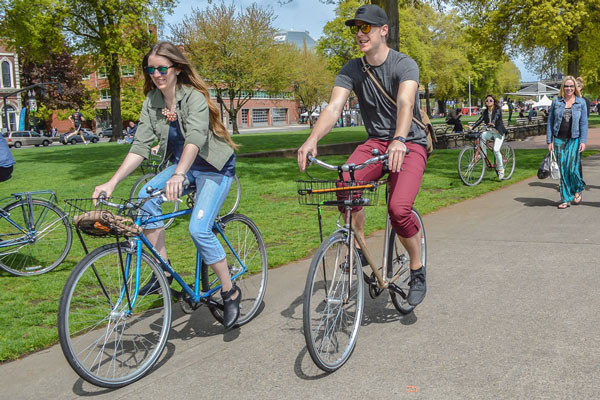
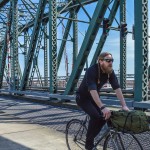
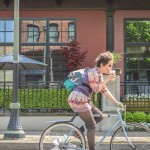
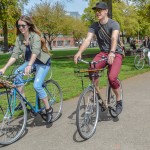
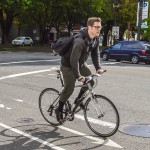
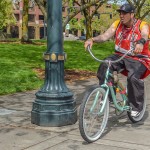
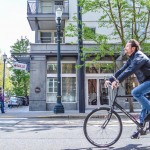
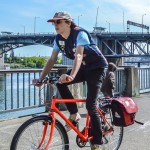

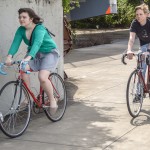
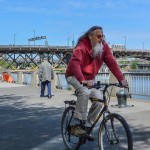
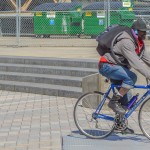
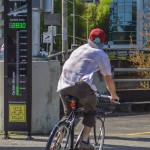


14 comments
Very interesting and thought-provoking piece. I noticed in your photos that almost no one was wearing a helmet! As you well know, the debate continues in BC and elsewhere as to the pros and cons of requiring helmets. Do you have any insights on this question from your Portland trip? What are their laws? Why was no one wearing a helmet?
Wondering in S. Granville (bike lane desert)
Thanks for your comment. I subscribe to the Cycle Chic style of photography and filmmaking. That is, encouraging people to “dress for the destination”, and choose “style over speed”. It promotes cycling in a positive manner, as something that’s perfectly safe, easy, and fun. The suggestion of inherent danger (while ignoring similar head injury risks whilst walking and driving) has been shown to direct people onto other, less active modes of transportation: http://www.copenhagenize.com/2013/10/promoting-cycling-positively-now-with.html.
The BC adult helmet law is a global anomaly (duplicated only in Australia and New Zealand), brought about by a worried suburban Mom and a single erroneous study. It has set back utility cycling in this province for decades, and the sooner it is repealed, the better. Then we can begin our own process of taking things to the next level, and start aiming for the double-digit mode shares seen in Asia and Europe.
Interesting article. I was also surprised of all the photos showing riders w/o helmets!! I have ridden to work in downtown Portland and home every week day for ten years. About 6 miles one way. Most people do wear helmets here, just so y’all know!
Cities who don’t construct a protective barrier between the rider and the street are complacent, but riders who don’t wear a protective barrier between their heads and the street aren’t? Interesting point of view.
I’ve always found protected bike lanes to be more dangerous on a daily basis (limited ability for cyclists to avoid obstructions, pedestrians who walk in or cross the lanes without looking, increased chance of clipping a wheel or foot on the curb), granted I only rode them regularly when they were first introduced in NYC. Thanks for the thought provoking piece!
Sadly, King County (Seattle and environs) has a mandatory helmet law for adults as well.
I chose to visit Portland in April 2012 specifically because it was being billed as the “Bike Capital of America”. I wanted to see what the best looked like in North America. What I saw made me want to cry. It is true that the drivers were courteous to cyclists. That part was lovely. But the infrastructure was ho-hum and there were hardly any cyclists! While it’s true that, as a tourist, I was not out and about during the morning rush hour, but I should have noticed the afternoon rush. I left Portland deflated, knowing that “the best” meant we still have so far to go.
Glad to see this article. It is time to call Portland to task for its retreat from making all streets safe for all.
One major missing part though is the importance of organized activism: Every bike lane, every parking spot, every bridge improvement came about because of the work of the Bicycle Transportation Alliance in the 1990s. A successful lawsuit (details here: http://gettingto2100.org/portlands-bicycle-revolution-started-with-a-lawsuit/), petitions, commute races, the BridgePedal ride that attracts 20,000 every year (a partnership of BTA and Rick Bauman)… and more, all were the work of dedicated volunteers (with a very small staff) of the BTA.
When we started the BTA, the City of Portland told us that “bike lanes weren’t necessary because no one rides bikes” so we sued and won. When we started, the transit agency, TriMet, said that bikes don’t belong on buses, so we did research, got 7000 signatures and many city council resolutions and got the first major city transit system to convert to 100% bike accessibility–we even got them to redesign the light rail cars for easy loading!
As Frederick Douglas said: “”Power concedes nothing without a demand. It never did and it never will.” That was the motto of the BTA in the beginning. Its telling that this group doesn’t even show up in this article while a pedestrian advocate and a bicycle journalist do. Where there is no agitation there is no progress!
Chris: From a life-long Portland bicyclist’s perspective, it’s important to add context to what I think is a pretty myopic piece. A few points:
-You’re wrong, there are protected bike lanes in the downtown core. Broadway at Portland State University is one example.
-The term the “best” “#1” and “hippest” are hard monikers for Portland to assume. (For that matter, ANY city to assume). We’re a DIY city that has become better through individual and collective ideas, not by some mission or marketing statement to be #1. The reason Portland may be the “best” is because it has a unique, like-no-other bike culture, not through technical upgrades or specific goal to outclass other cities. Stop putting us on a pedestal…
-That said, the city will soon open the country’s first bridge designed to carry light rail trains, buses, cyclists, pedestrians and streetcars, but not private vehicles. Does that mean that citizens of “progressive Portlandia” (your term) think we’re now at the top of the heap. No. I’m all for another city doing us one better, or, better yet, doing themselves one better.
-Unfortunately, this biking, progressive pretentiousness was compounded by our last mayor whose mission was to promote boutique bicycle projects. I’m all for improving the bicycle infrastructure but, unfortunately, Mayor Adams took it too far, especially for the common citizen who also saw misspending in other quarters. The reaction has been to vote in a less bike friendly (but not bike negative) mayor and city government. The pendelum will swing back and, in the meantime, the city will continue to foster good planning and great bike infrastructure….
(my two cents)…
What I find interesting is the poor quality of the bicycles shown in the photographs. Although Portland is notoriously rainy, many (perhaps most, I did not count!) did not have fenders. Same observation applies for chainguards. Riding one of those bikes on a wet road will result in road filth being thrown onto the rider. Not good!
Very few of the bicycles appeared to have internal hub gears and brakes. Very few had rear racks, front baskets or any other cargo capacity.
Most scary is that most of the bicycles shown appear to be missing lights. Wow! That’s dangerous!
In short, most of the bicycles shown are of poor quality and highly inappropriate for transportation cycling.
Compare this with the much higher quality of bicycles used by people in this video taken in Utrecht:
http://bicycledutch.wordpress.com/2013/10/10/utrecht-morning-rush-hour/
I cannot believe you are debating helmet laws here. Where I live in Melbourne Australia, they have become the bane of our existence.
They severely limit the success of our share bike scheme, they provide meat for the tabloids “he wasn’t wearing a helmet the scofflaw”, their efficacy is questionable, and they serve to separate cycling as a dangerous outsider activity instead of a normal behaviour.
Don’t let them bring in mandatory helmet laws. You will regret it.
I’ve lived in Portland without a car for nearly 14 years, and it is a crappy place to ride a bicycle. It’s better than most other places in America, but that’s not saying much (particularly compared to Copenhagen or Amsterdam). The bicycling facilities generally range from poor to dangerous, and I’m reluctant to allow my five-year old to ride in the street. It’s unfortunate that groups like the League of American Bicyclists bestowed “Platinum” status on Portland, which reinforced the notion things are great here.
The problem is that Portland is an American city, and most Americans would almost rather die than give up their cars. Even very liberal, well-educated Portlanders like my most of neighbors simply cannot imagine life without the convenience of car ownership. Portland politicians are savvy enough to understand this. Most people in our liberal city pay lip service to the idea of climate change and alternative transportation, but the overwhelming majority of voters have at least one car parked in front of their house. As a result, there’s little political will to create the type of first class bicycling facilities that make cities like Copenhagen so wonderful.
Portland will muddle along, and we’ll likely stay as one of the top bicycling cities in the United States. But, that’s never really going to mean much until American society as a whole becomes less fixated on car ownership.
Interesting article, and I generally agree that Portland has drastically slowed it’s forward progress. I would point to an as yet unmentioned reason however: the vastly different ideas of what makes things better. The handful of comments so far are a pretty good snapshot:
– S Lynn, Ryan, and Cecily say if you aren’t wearing a helment you’re doing it wrong.
– Rex says if you aren’t agitating with the BTA you’re doing it wrong.
– J.W. says our new private-auto-free bridge (admittedly pretty impressive both in theory and in real life) shows we are actually doing it right.
– Kevin says our bikes are crappy so we’re doing it wrong.
– And Jeff says if you own a car, even if it sits in front of the house 29 days a month, you’re doing it wrong.
(I’m paraphrasing…)
We have picked most of the low-hanging fruit, and I’m afraid that until our city leaders are as willing to ruffle some auto-dependent feathers as has Rahm or Ed have done, we will stay on pause. I will cop to being a “strong and fearless” rider who is not deterred by…well anything really. I also know that most other cyclists or would-be cyclists are not that way, and until they believe they can get where they want to go without dying or – more importantly – even having to think about it, they’ll sit it out for many potential trips.
We will also continue to be stymied by a lack of funding. Until there is a meaningful discussion about transportation funding, (as with education funding,) cars will win, if only because it costs a lot more to provide a minimal level of service to cars versus bikes.
But back to my original point, the “bike lobby” if such a thing exists (outside of Rex’s BTA) spends as much time fighting itself that it is no wonder the going is slow. Some “cyclists” put their bike on the roof of their car and drive 4 miles to their favorite take-off spot / parking lot to join their spandexed peers. They could never imagine spending on bike infrastructure in between because the car is their transportation mode and the bike is their pleasure dome and never the two shall meet. Others say the bike is the PERFECT MACHINE and any other transportation is probably the work of the devil.
Somewhere in the middle (or far to the left or right…) may lie the truth. Sadly our fractured desires mean those solely focused on getting to work, the store, and home in their single-occupant vehicle will keep winning the tug-of-war for funding because their voice AND VOTE is more united: “BUILD US MORE ROADS!”
@Kevin: All the photos in question seem to have dry roads and daylight so what’s the problem? It’s obvious you think bikes should be Dutch or nothing. That’s fine for you but no need to tell off other people when they’re not doing anything wrong. If it has a few wheels and pedals and works it’s a good bike. And if you think the above are bad don’t ever go to Berlin, the state of bikes there would give you a heart attack.
Dear Derek,
The problem is that this is notoriously rainy Portland. Wet roads are quite a frequent occurrence. My boss has this strange idea that I should show up at work whether or not it is raining. And definitely not covered with road filth. Career-limiting move, that.
Darkness also seems to come every day. I have not had to be home by dark since I was 8 years old. Lights on my bike allow me to continue to be out after dark.
Also my wife has a habit of sending me a grocery list before I leave work to come home. Panniers, a rear rack and front basket allow me to carry quite a lot of groceries for myself, my wife and our three children. Even people who do not have a family still have to eat.
The article is about Portland’s claim to be “America’s Bicycle Capital.” That means bicycles which are a bit more than toys for recreational purposes. Now don’t get me wrong, I am not anti-fun. If someone wants to go racing or unicycling or whatever, go for it. But a bicycle that is a functional tool for transportation has to work in all weathers, be reliable and low-maintenance and carry my stuff wherever I go.